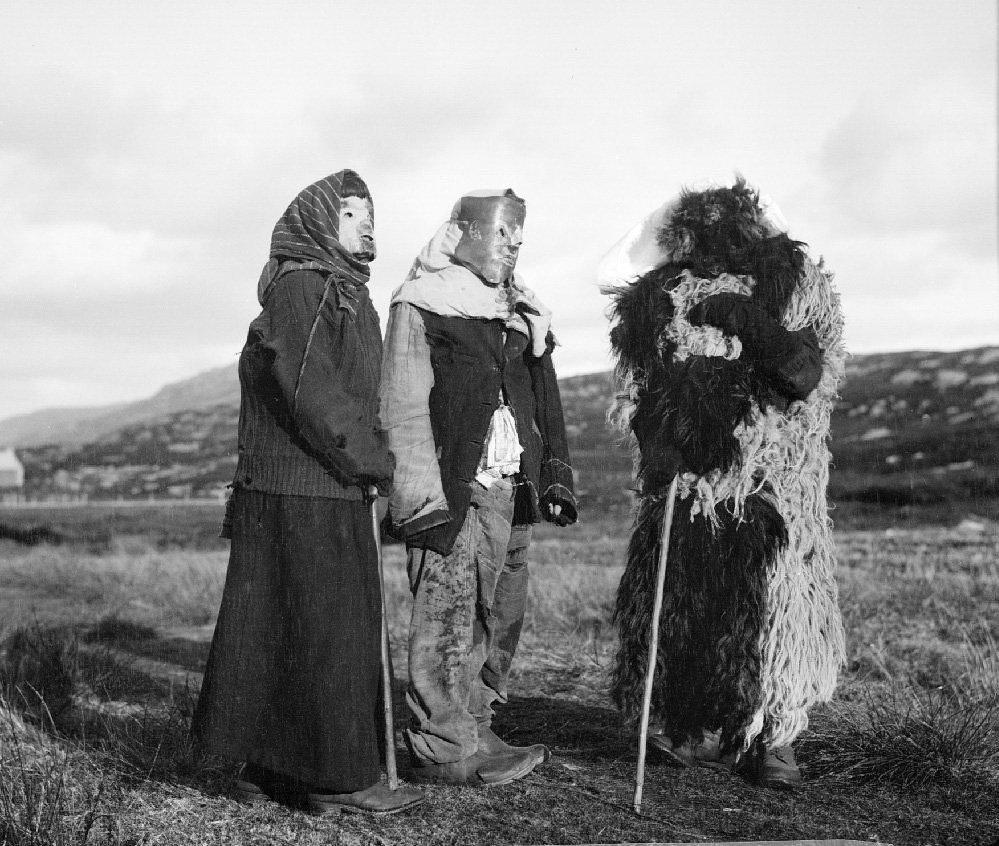
Halloweens Past: Gìsearachd, Cabbage Stalks and Egg Whites
This article was written by Dr Decker Forrest, Programme Leader for the BA (Hons) Gaelic and Traditional Music programme at Sabhal Mòr Ostaig. It was first published in the West Highland Free Press.
Oidhche Shamhna or Halloween is one of the most important and longstanding celebrations of the Celtic festival calendar. Its original significance – centred on themes of fertility and harvest, the protection from evil through the appeasement of gods and, later, holy saints – has in more recent times given way to a clear, single-minded emphasis on social gatherings, pranks, games, bonfires and food. In a word – fun. Given the historical importance of Halloween, it is of little surprise that on entering ‘Halloween’ into the Tobar an Dualchais search engine, no less than 180 individual recordings in both Gaelic and Scots appear. A quick trawl through some of these recordings reveals a fascinating and often humorous mix of customs, songs and anecdotes from across Scotland recorded mostly between about 1950 and 1980 but relating to as far back as the late 19th century or even earlier.

It is worth noting that the actual date that Halloween was celebrated comes up frequently. 11 November (Martinmas), sometimes referred to as ‘Old Halloween’, was observed in many districts throughout Scotland into the 20th century and marked one of the old Scottish Term or Quarter Days when farm tenancies and employment began and ended. The theme of seasonal change and the agricultural cycle is summed up in a saying once synonymous with Oidhche Shamhna and frequently quoted within TAD recordings: Oidhche Shamhna theirear gamhna ris na laoigh (‘On Halloween the calves become stirks’)
You are given the impression of a pan-Scottish occasion with an array of customs strikingly similar throughout the country. Gìsearan or Guisers went door to door and as William Walker (1883-1968) from Killin recalled, would chant the rhyme ‘Here I come galoshin [guising]; Galoshin is ma name; with sword and pistol by my side, I’ve come tae play the game’. Costumes could involve little more than the boys turning their coats inside out. In places like South Uist, however, they could be outright terrifying. Archie MacDonald (Eairdsidh Raghnaill 1893-1973) recalled aodainnean (masks) being made from sheepskin with painted features added: “...b’ e sin a’ chulaidh-eagail, tachairt riut feadh na h-oidhche!” (‘that would certainly frighten you if you met one during the night!’). The recitation of rhymes, songs and riddles were a feature of the visits and were generally rewarded with scones or, latterly, a few coins. Fuarag, made with oatmeal, cream and sugar and into which a coin or ring was added was a Halloween standard throughout the Highlands and Islands.

Perhaps the greatest recurring Halloween theme on TAD is that of the tireless creative efforts to predict the future husbands and wives of children. Eggs were often employed for this purpose, typically by combining the white of an egg with water in a glass and then interpreting the resulting patterns. Donald Alasdair Johnson (Dòmhnall Alasdair mac Iain Mhòir) from South Uist recalled a slightly more elaborate practice of breaking an egg into a glass and stirring it before each child took a mouthful, chose a house and stood outside its window. Waiting stealthily, egg mix in mouth, the child would wait to hear the first name mentioned from inside which would foretell the name of his or her future spouse! Donald Alasdair went on to describe other practices including the pulling of a straw from a haystack by the teeth; the number of grains at the end foretelling the number of children the child would one day have. He also described setting out saucers containing earth, salt, clean water and dirty water on a table. A blindfolded child then placed his or her hand in one. Earth foretold death, salt predicted that they would either become or marry a sailor, clean water meant they would become or marry a rich man while dirty water foretold of an illegitimate child. There were, of course, many variants of this popular game throughout the country.
The pulling up of cabbage stalks and turnips to tell the future was widespread and the Reverend Norman MacDonald (1904-1978) from Valtos in Skye, one of the School of Scottish Studies' greatest and most prolific contributors, recalled that a girl could tell whether her future husband would be tall or short, thin or fat, by the form of the stalk she pulled from the ground. Furthermore, the amount of soil which remained stuck to the stalk foretold the man’s wealth; the more the better. Reverend MacDonald recalled a number of other Halloween customs including the placement of two nuts, representing a betrothed couple, in a blacksmith’s forge. If they burned together, the couple would be married within a year. If they leapt apart, they would part and if only one nut burned, there would be no wedding. One final practice, typically carried out late at night in a barn involved a girl throwing a ball of yarn or string over a rafter, calling out, Cò tha siud shuas air ceann mo ròpa? (‘Who is that at the end of my rope?’). The future husband would answer. TAD includes recordings of sisters Peggy and Mary MacRae (Peigi is Màiri Anndra) from South Uist singing a waulking song connected with this popular game which had, as ever, many variants.
Mischief was clearly a major feature of Halloweens past and on this subject the clarity of memory amongst those on Tobar an Dualchais becomes notably acute. The removal and hiding of gates, often at a considerable distance, was standard practice as was the blocking of chimneys with turnips or by other means. Turnips, along with cabbages and carrots had other uses on Halloween, if only to be thrown against the doors of houses as Angus MacKay (Aonghas Aonghais ’ic Iain Mhòir 1889-1965), South Uist, recalled. Mary MacCormick (Màiri Ruairidh Eòin), Barra, remembered vividly how the older boys in the village would take the wheels from carts and pull boats up onto the shore. The careful tying of household items together seems to have been a speciality in Barra and Mary recalled how two elderly ladies found (rather too late to their great misfortune) that a chamber pot had been tied to a door during the night!
The references above do not even begin to scratch the surface of the Tobar an Daulchais. The detail, subtlety of delivery, dualchainnt and terminology of the individuals recorded offer listeners a precious insight into Scotland’s cultural heritage.